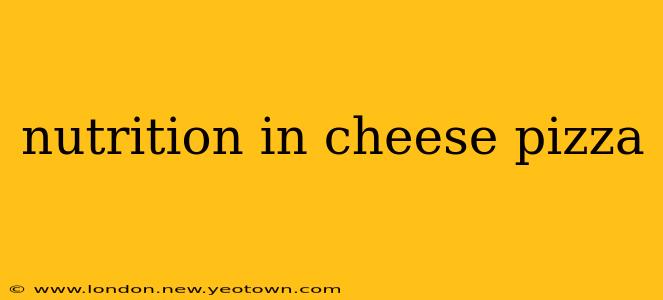Pizza. The very word conjures images of warm, gooey cheese, tangy tomato sauce, and perfectly crisp crust. But beyond the deliciousness, lies a question many pizza lovers ponder: what's the actual nutritional content of this beloved dish? Let's unravel the nutritional landscape of cheese pizza, exploring its components and offering a balanced perspective.
What are the main nutritional components of cheese pizza?
A typical slice of cheese pizza is a complex mix of carbohydrates, fats, proteins, and various micronutrients. The crust provides the carbohydrates, primarily in the form of simple starches. The cheese contributes significantly to the fat and protein content, delivering saturated fats, along with calcium and other essential minerals. The tomato sauce adds a dose of vitamins, particularly lycopene, a powerful antioxidant. However, the specific nutritional breakdown varies wildly depending on the pizza's size, the type of crust (thin crust versus deep dish), the cheese used (mozzarella, provolone, etc.), and the ingredients in the sauce.
How many calories are in a typical slice of cheese pizza?
This is a tricky question without a definitive answer! A single slice can range anywhere from 200 to 350 calories, sometimes even more. Think of it this way: a larger, thicker crust pizza with extra cheese will pack a bigger caloric punch than a thin-crust slice with minimal toppings. To get a precise calorie count, you’d need to check the nutritional information provided by the pizzeria or restaurant. Many chains now publish this information online or on their packaging.
Is cheese pizza a healthy food choice?
This is a question with a nuanced answer. Cheese pizza, on its own, isn't inherently "unhealthy," but it's not exactly a health food superstar either. A slice here and there won't derail your diet, especially if you're otherwise eating a balanced diet. However, regular consumption of high-calorie, high-fat pizza can contribute to weight gain and other health issues if not balanced with other healthy food choices and sufficient physical activity. Moderation is key!
What are the benefits of eating cheese pizza (in moderation)?
Believe it or not, even cheese pizza offers some nutritional advantages when enjoyed sparingly. The cheese provides calcium, essential for strong bones and teeth. The tomato sauce contributes lycopene, linked to reduced cancer risk. The crust, depending on its ingredients, can provide some fiber, contributing to digestive health. The key word here is moderation. These benefits are significantly outweighed by the negative aspects if eaten frequently.
What are the drawbacks of eating cheese pizza frequently?
Excessive cheese pizza consumption can lead to a number of health concerns. The high saturated fat content can raise cholesterol levels, increasing the risk of heart disease. The high sodium content in both the cheese and sauce can contribute to high blood pressure. The refined carbohydrates in the crust can spike blood sugar levels, potentially leading to insulin resistance and type 2 diabetes.
How can I make healthier choices when ordering pizza?
If you're craving pizza, there are ways to make healthier choices. Opt for a thin crust to reduce the carbohydrate load. Choose a pizza with plenty of vegetables to increase your intake of vitamins and fiber. Consider sharing a large pizza with friends or family to control portion sizes. You could even explore making your own pizza at home, using whole-wheat crust and plenty of fresh vegetables. Remember, even small changes can make a difference in your overall nutritional intake.
This detailed exploration provides a balanced view of cheese pizza's nutritional profile. Remember that mindful eating and balance are crucial for maintaining a healthy lifestyle. Enjoy your pizza in moderation, and pair it with a well-rounded diet and active lifestyle!

